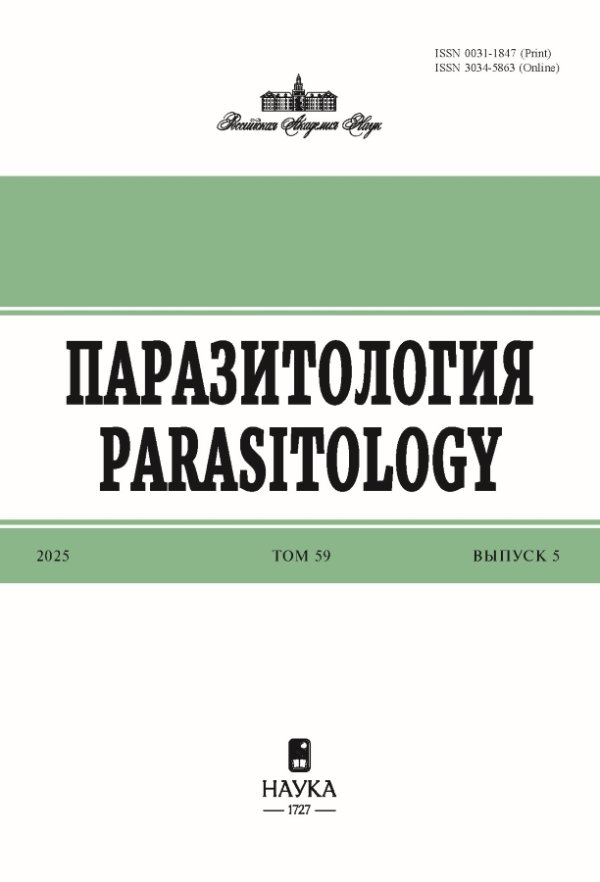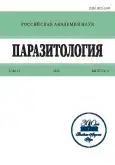Secretion of dermal glands in freshwater mites (acariformes, parasitengonina, hydrachnidia) and its structural characteristics
- Authors: Shatrov A.B.1
-
Affiliations:
- ФГБУН Зоологический институт РАН
- Issue: Vol 57, No 4 (2023)
- Pages: 319-336
- Section: Articles
- URL: https://journals.rcsi.science/0031-1847/article/view/142140
- DOI: https://doi.org/10.31857/S0031184723040038
- EDN: https://elibrary.ru/KHCRXG
- ID: 142140
Cite item
Full Text
Abstract
Keywords
References
- Вайнштейн Б.А. 1978. Определитель обитающих в почве клещей. Trombidiformes. М., Наука, 269 с.
- Vainshtein B.A. 1878. Opredelitel' obitayushchikh v pochve kleshchei Trombidiformes. Moscow, Nauka, 269 pр. (In Russian).
- Шатров А.Б. 2000. Краснотелковые клещи и их паразитизм на позвоночных животных. Санкт-Петербург, Изд-во СПбГУ, 276 с.
- Shatrov A.B. 2000. Krasnotelkovye kleshchi i ikh parasitism na pozvonochykh zhivotnykh. SPb GU, 276 pр. (in Russian).
- Шатров А.Б. 2013. Дермальные железы водяных клещей (Acariformes: Parasitengona: Hydrachnidia) и их возможное эколого-физиологическое значение. Паразитология 47 (3): 235-244.
- Shatrov A.B. 2013. Dermals glands of aquatic mites (Acariformes: Parasitengona: Hydrachnidia) and their possible ecological and physiological significance. Parazitologiya 47 (3): 235-244. (In Russian).
- Akai H. 1984. The ultrastructure and functions of the silk gland cells of Bombyx mori. In: King R.C., Akai H. (eds). Insect Ultrastructure, v. 2. New-York, London, Plenum Press, 323-364.
- Akai H., Hakim R.S., Kristensen N.P. 2003. Labial glands, silk and saliva. In: Niels P. Kristensen (ed.). Lepidoptera, Moth and Butterflies. Vol. 2: Morphology, Physiology, and Development. Berlin, New York, Walter de Gruyter, 377-388.
- Alberti G., Coons L.B. 1999. Acari: Mites. In: Harrison F.W., Foelix R.F. (eds.). Microscopic Anatomy of Invertebrates, v. 8C. New York, Wiley-Liss, 515-1217.
- Alberti G., Ehrnsberger R. 1977. Rasterelektronenmikroskopische Untersuchungen zum spinnvermögen der Bdelliden und Cunaxiden (Acari, Prostigmata). Acarologia 19: 55-61.
- Ashton N.N., Taggart D.S., Stewart R.J. 2011. Silk tape nanostructure and silk gland anatomy of Trichoptera. Biopolymers 97: 432-445. https://doi.org/10.1002/bip.21720
- Annamalai M., Jayaprakash K. 2012. Structural studies on silk protein fibre from pseudoscorpion. International Journal of Life Science & Pharma Research 2: 49-54.
- Blackledge T.A. 2013. Spider silk: molecular structure and function in webs. In: Nentwig W. (ed.). Spider Ecophysiology. Berlin, Heidelberg, Springer Verlag, 267-280.
- Blackledge T.A., Scharffb N., Coddington J.A., Szütsb T., Wenzeld J.W., Hayashie C.Y., Agnarsson I. 2009. Reconstructing web evolution and spider diversification in the molecular era. PNAS 106: 5229-5234. https://doi.org/10.1073_pnas.0901377106
- Bakker De D., Beatens K., Van Nimmen E., Gellynck K., Mertens J., Van Langenhove L., Kiekens P. 2006. Description of the structure of different silk threads produced by the water spider Argyroneta aquatica (Clerck, 1757) (Araneae: Cybaeidae). Belgien Journal of Zoology, 136: 137-143.
- Bolland H.R. 1983. A description of Neophyllobius aesculi n. sp. and its developmental stages (Acari: Camerobiidae). Entomologische Berichten 43: 42-47.
- Böttger K. 1962. Zur Biologie und Ethologie der einheimischen Wassermilben Arrenurus (megaluracarus) globator (Müll.), 1776, Piona nodata nodata (Müll.), 1776, und Eylais infundibulifera meridionalis (Thon), 1899 (Hydrachnellae, Acari). Zoologische Jahrbücher. Abteilung für Systematik, Geographie und Biologie der Tiere 89: 501-584.
- Büsse S., Hörnschemeye T., Hohu K., McMillan D., Edgerly J.S. 2015. The spinning apparatus of webspinners - functional-morphology, morphometrics and spinning behavior. Scientific Report 5: 9986. https://doi.org/10.1038/srep09986
- Clotuche G., Mailleux A.-C., Astudillo F.A., Deneubourg J.-L., Detrain C., et al. 2011. The formation of collective silk balls in the spider mite Tetranychus urticae Koch. PLoS ONE 6: e18854. https://doi.org/10.1371/journal.pone.0018854
- Craig C.L. 1997. Evolution of arthropod silks. Annual Revue of Entomology 42: 231-267.
- Craig C.L. 2003. Spiderwebs and silk: Tracing evolution from molecules to genes to phenotypes. Oxford, Oxford University Press Inc.256 pp.
- Craig C.L., Riekel C., Herberstein M.E., Weber R.S., Kaplan D., Pierce N.E. 2000. Evidence for diet effects on the composition of silk proteins produced by spiders. Molecular Biology and Evolution 17: 1904-1913. https://doi.org/10.1093/oxfordjournals.molbev.a026292
- Dabert M., Proctor H., Dabert J. 2016. Higher-level molecular phylogeny of the water mites (Acariformes: Prostigmata: Parasitengonina: Hydrachnidiae). Molecular Phylogenetics and Evolution 101: 75-90. https://doi.org/10.1016/j.ympev.2016.05.004
- Edwards D.D., Vidrine M. F. 2006. Host specificity among Unionicola spp. (Acari: Unionicolidae) parasitizing freshwater mussels. Journal of Parasitology, 92 (5): 977-983.
- Engster M.S. 1976. Studies on silk secretion in the Trichoptera (F. Limnefilidae). I. Histology, histochemistry, and ultrastructure of the silk glands. Journal of Morphology 150: 183-212.
- Foelix R.F. 1996. Biology of Spiders. Oxford, Oxford University Press Inc.326 pp.
- Fernandez A.A., Hance T., Clotuche G., Mailleux A-C., Deneubourg J.L. 2012. Testing for collective choices in the two-spotted spider mite. Experimental and Applied Acarology 58: 11-22. https://doi.org/10.1007/s10493-012-9558-5
- Gerson U. 1985. Webbing. In: Helle W., Sabelis M.W. (eds.) Spider mites. Their biology, natural enemies and control, v. 1A. Amsterdam, Elsevier, 223-232.
- Hatano T., Nagashima T. 2015. The secretion process of liquid silk with nanopillar structures from Stenopsyche marmorata (Trichoptera: Stenopsychidae). Scientific Reports 5: 9237. https://doi.org/10.1038/srep09237
- Hunt S. 1970. Amino acid composition of silk from the pseudoscorpion Neobisium maritimum (Leach): a possible link between the silk fibroins and the keratins. Comparative Biochemistry and Physiology 34: 773-776.
- Johnson M-L., Merritt D.J., Cribb B.W., Trent C., Zalucki M.P. 2006. Hidden trails: visualizing arthropod silk. Entomologia Experimentalis et Applicata 121: 271-274. https://doi.org/10.1111/j.1570-8703.2006.00447.x
- Kakui K., Hiruta C. 2014. Diverse pereopodal secretory systems implicated in thread production in an apseudomorph tanaidacean crustacean. Journal of Morphology 275: 1041-1052. https://doi.org/10.1002/jmor.20281
- Kanazawa M., Sahara K., Saito Y. 2011. Silk threads function as an 'adhesive cleaner' for nest space in a social spider mite. Proceedings of the Royal Society - biological sciences 278: 1653-1660. https://doi.org/10.1098/rspb.2010.1761
- Kerfoot W.C. 1982. A question of taste: crypsis and warning coloration in freshwater zooplankton communities. Ecology 63 (2): 538-554.
- Kerkam K., Viney C., Kaplan D., Lombardi S. 1991. Liquid crystallinity of natural silk secretion. Nature 349: 596-598.
- Kirstein K-G., Martin P. 2009. Die glandularien der Wassermilben (Hydrachnidia, Acari) - ihre Funktion als Wehrdrüsen. Deutsche Gesellschaft für Limnologie (DGL), Erweiterte Zusammenfassungen der Jahrestagung 2008 (Konstanz), Hardegsen, 2009: 571-575.
- Kirstein K-G., Martin P. 2010. Die glandularien der Wassermilben (Hydrachnidia, Acari) - Die Wehrdrüsensekrete im Vergleich. Deutsche Gesellschaft fur Limnologie (DGL), Erweiterte Zusammenfassungen der Jahrestagung 2009 (Oldenburg), Hardegsen, 2010: 433-437.
- Knight D.P., Vollrath F. 2002. Spinning an elastic ribbon of spider silk. Philosophical Transactions of the Royal Society of London, B, 357: 219-227. https://doi/org/10.1098/rstb.2001.1026
- Kovoor J. 1987. Comparative structure and histochemistry of silk-producing organs in Arachnids. In: Nentwig W. (ed.). Ecophysiology of Spiders. Berlin, Heidelberg, Springer-Verlag, 160-186.
- Kovoor J., Zylberberg L. 1980. Fine structural aspects of silk secretion in a spider (Araneus diadematus). I. Elaboration in the pyriform glands. Tissue and Cell 12: 547-556.
- Kovoor J., Zylberberg L. 1982. Fine structural aspects of silk secretion in a spider. II. Conduction in the pyriform glands. Tissue and Cell 14: 519-530.
- Kronenberger K., Moore P.G., Halcrow K., Vollrath F. 2012. Spinning a marine silk for the purpose of tube-building. Journal of Crustacean Biology 32: 191-202. https://doi.org/10.1163/193724011X615532
- Le Goff G.J., Hance T., Detrain C., Deneubourg J.-L., Clotuche G., Mailleux A.-C. 2011. Impact of starvation on the silk attractiveness in a weaving mite, Tetranychus urticae (Acari: Tetranychidae). Journal of Ethology 30: 125-132. https://doi.org/10.1007/s10164-011-0305-x
- Manson D.C.M., Gerson U. 1996. Web spinning, wax secretion and liquid secretion by eriophyoid mites. In: Lindquist E.E., Sabelis M.W., Bruin J. (eds) Eriophyoid mites - their biology, natural enemies and control. BV, Elsevier, 251-258.
- Osborn Popp T.M., Addison J.B., Jordan J.S., Damle V.G., Rykaczewski K., Chang S.L.Y., Stokes G.Y., Edgerly J.S., Yarger J.L. 2016. Surface and wetting properties of embiopteran (webspinner) nanofiber silk. Langmuir. 32: 4681-4687. https://doi.org/10.1021/acs.langmuir.6b00762
- Proctor H.C. 1991. Courtship in the water mite Neumania papillator: males capitalize on female adaptations for predation. Animal Behavior 42: 589-598.
- Proctor H.C. 1992. Mating and spermatophore morphology of water mites (Acari: Parasitengona). Zoological Journal of Linnean Society 106: 341-384.
- Proctor H., Garga N. 2004. Red, distasteful water mites: did fish make them that way? Experimental and Applied Acarology 34: 127-147.
- Rudall K.M., Kenchington W. 1971. Arthropod silks: the problem of fibrous proteins in animal tissues. Annual Review of Entomology 16: 73-96.
- Schaller F. 1971. Indirect sperm transfer by soil arthropods. Annual Review of Entomology 16: 407-446.
- Sehnal F., Akai H. 1990. Insect silk glands: their type, development and function, and effects of environmental factors and morphogenetic hormones on them. Internal Journal of Insect Morphology and Embryology 19: 79-132.
- Shatrov A.B. 2008. Organization of unusual idiosomal glands in a water mite, Teutonia cometes (Teutoniidae). Experimental and Applied Acarology 44 (5): 249-263.
- Shatrov A.B. 2013. Anatomy and ultrastructure of dermal glands in an adult water mite, Teutonia cometes (Koch, 1837) (Acariformes: Hydrachnidia: Teutoniidae). Arthropod Structure and Development 42: 115-125. https://doi.org/10.1016/j.asd.2012.10.006
- Shatrov A.B., Soldatenko E.V. 2016. Dermal glands in freshwater mites Limnesia undulata (O.F. Müller, 1776) and L. fulgida (C.L. Koch, 1836) (Acariformes, Limnesiidae). Arthropod Structure and Development 45: 341-355. https://doi.org/10.1016/j.asd.2016.05.003
- Shatrov A.B., Soldatenko E.V. 2022. Organization of dermal glands and characteristic of secretion in the freshwater mite, Limnesia maculata (O.F. Muller, 1776) (Acariformes, Limnesiidae). Journal of Morphology 283: 346-362. http://doi.org/10.1002/jmor.21447
- Shatrov A.B., Soldatenko E.V., Gavrilova O.V. 2014. Observation on silk production and morphology of silk in water mites (Acariformes: Hydrachnidia). Acarina 22: 133-148.
- Shatrov A.B., Soldatenko E.V., Gavrilova O.V. 2016. Morphology of tube-like threads related to Limnochares aquatica (L., 1758) (Acariformes: Hydrachnidia: Limnocharidae) in the laboratory. Journal of Natural History 50: 2199-2214. https://doi.org/10.1080/00222933.2016.1193643
- Shatrov A.B., Soldatenko E.V., Stolbov V.A., Smirnov P.A., Petukhova O.A. 2019. Ultrastructure and functional morphology of dermal glands in the freshwater mite Limnochares aquatica (L., 1758) (Acariformes, Limnocharidae). Arthropod Structure and Development 49: 85-102. https://doi.org/10.1016/j.asd.2018.11.010
- Smith B.P., Hagman J. 2002. Experimental evidence for a female sex pheromone in Arrenurus manubriator (Acari: Hydrachnida; Arrenuridae). Experimental and Applied Acarology 27: 257-263. https://doi.org/10.1023/a:1023328428716
- Sponner A., Vater W., […], Weisshart K. 2007. Composition and hierarchical organisation of a spider silk. PLoS ONE 2: e998. https://doi.org/10.1371/journal.pone.0000998
- Stubbs D.G., Tillinghast E.K., Townley M.A. 1992. Fibrous composite structure in a spider silk. Naturwissenschaften 79: 231-234.
- Sutherland T.D., Young J.H., Weisman S., Hayashi C.Y., Merritt D.J. 2010. Insect silk: one name, many materials. Annual Revue of Entomology 55: 171-188. https://doi.org/10.1146/annurev-ento-112408-085401
- Vollrath F. 2000. Strength and structure of spiders' silks. Biotechnology and Molecular Biology Reviews 74: 67-83. https://doi.org/10.1016/s1389-0352(00)00006-4
- Vollrath F., Knight D.P. 2001. Liquid crystalline spinning of spider silk. Nature 410: 541-548. https://doi.org/10.1038/35069000
- Vollrath F., Holtet T., Thøgersen H.C., Frische S. 1996. Structural organization of spider silk. Proceedings of the Royal Society of London. Series B, Biological Sciences 263: 147-151.
- Wallace M.M.H., Mahon J.A. 1972. The taxonomy and biology of Australian Bdellidae (Acari). I. Subfamilies Bdellinae, Spinibdellinae and Cytinae. Acarologia 14: 544-580.
- Wiles P.R. 1997. The homology of glands and glandularia in the water mites (Acari: Hydrachnidia). Journal of Natural History 31: 1237-1251.
- Witte H. 1991. Indirect sperm transfer in prostigmatic mites from a phylogenetic viewpoint. In: Schuster R., Murphy P.W. (eds). The Acari: Reproduction, Development and life history strategies. London, Chapman & Hall, 173-178.
- Witte H., Döring D. 1999. Canalized pathways of change and constraints in the evolution of reproductive modes of microarthropods. Experimental and Applied Acarology 23: 181-216.
- Yano S. 2012. Cooperative web sharing against predators promotes group living in spider mites. Behavioral Ecology and Sociobiology. Available from: http://hdl.handle.net/2433/153051
- Yonemura N., Sehnal F., Mita K., Tamura T. 2006. Protein composition of silk filaments spun under water by caddisfly larvae. Biomacromolecules 7: 3370-3378. https://doi.org/10.1021/bm060663u
- Young J.H., Merritt D.J. 2003. The ultrastructure and function of the silk-producing basitarsus in the Hilarini (Diptera: Empididae). Arthropod Structure and Development 32: 157-165. https://doi.org/10.1016/S1467-8039(03)00006-9
Supplementary files










